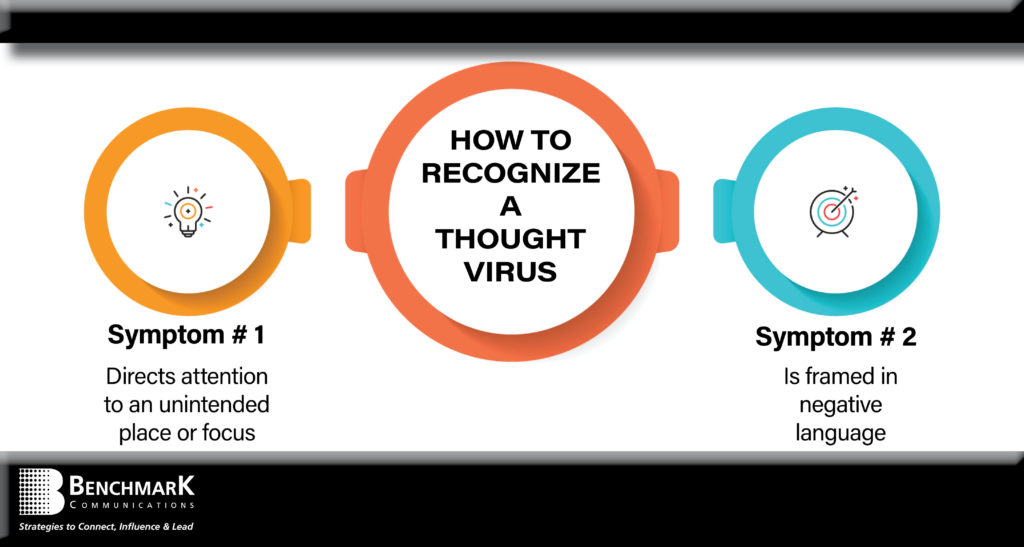News reporters are spewing out COVID-19 crisis stories around the clock. There is another virus worthy of your full attention as you help lead your organization through this time of testing. It is a communication virus that our team at Benchmark Communications calls a Thought Virus. This virus contaminates your daily messaging and communications. It impacts your ability to positively influence others and can harm your credibility as a leader. If undetected, a Thought Virus comes with a long list of side effects. It impacts the quality of your relationships, contaminates communications and causes people to not hear your intended messages.
How to Recognize This Virus
It is fairly easy to recognize a Thought Virus. It has two key symptoms. First, this virus directs attention where you do NOT want it to go! Second, it contains negative-framed language. This results in contaminated thoughts that make it harder for people to hear your intended message.
Messaging Impact
As communication strategists and trainers, we collect Thought Virus examples and the following is a good one. A friend of mine asked advice for a “difficult” conversation with a relative. She had gone in business with this relative and realized it was a mistake. Yet my friend wanted to preserve the personal relationship. She planned to start the conversation with, “Now, don’t take this personally, but…” Yikes! This is a great example of a Thought Virus. That opening message would have contaminated the entire conversation. It would have directed the attention to a very bad place. In turn, she would have not achieved her outcome. Even worse, she could have damaged the relationship.
How It Directs Messaging Attention
A powerful communication presupposition we use daily is “Energy flows where attention goes.” Each day you are constantly directing the attention of others, whether you realize it or not. You do this with your verbal messages and nonverbal cues. The specific words you choose greatly impact whether or not your messages are accepted. A Thought Virus focuses on the downside of things. This is why it causes all of the attention to go to the negative or problem. Alert: THERE IS a time to direct attention to negatives! But trouble comes when you insert a Thought Virus at the wrong place in your message. By doing this, you can break rapport and sabotage your intended communication goals.
Thought Virus Examples
We work with many Fortune 500 companies to develop their leaders and improve their teams’ communication skills. This allows us to collect a wide variety of Thought Virus examples. We discovered the following examples while helping clients improve speeches, messages, customer service and other communications. In each example, notice where the Thought Virus sends your attention. This is key to identifying a Thought Virus!
Communication Context: A manager was introducing a day-long training to his team.
Message With a Thought Virus: “Now, I know many of you are dreading this, but…”
Communication Context: A customer service representative was responding to a customer complaint.
Message With a Thought Virus: “I am so sorry for all of your frustration.”
Communication Context: A vendor was reaching out to a client to clear up some miscommunication.
Message With a Thought Virus: “So sorry about all the confusion.”
Branded Thought Viruses
I often wonder if NASA leaders realize that a Thought Virus is attached to their brand. Years ago, they adopted the tagline, “Failure is not an option.” Every time I see a t-shirt or bumper sticker with this NASA tagline, I think of NASA disasters. I recall the two space shuttle tragedies. It attaches the Thought Virus of “failure” to the NASA brand.
Word Choice & Science
You now know that a Thought Virus is packaged with negative words. There is scientific proof to support the case that each word you choose has neurological consequences. Studies show that negative word patterns result in the release of negative hormones and neurotransmitters in the brain. At the other end of the spectrum, positive words stimulate the brain’s frontal lobes and release chemicals that make you feel good.
“Studies show your words direct the release of hormones and neurotransmitters in the brain.”
Negative words trigger increased activity in the fear center of the brain called the amygdala. This can result in a partial shutdown of the reasoning and logic centers located in the frontal lobes. As a result, negative words have the power to make you feel tense, nervous and even fearful.
How to Build Virus Immunity
You might assume that our team is immune to Thought Viruses since we continually study communication, language and the impact on behavior. But we are mere humans! Therefore, we catch ourselves occasionally coughing up Thought Viruses.
As with all skills and success, increased awareness is the key. The good news is that you will eliminate most Thought Viruses from your communications as you increase your awareness. In turn you will be able to make quicker corrections in your verbal and written communications. With practice you can build a very high awareness and immunity.
INVEST IN POWERFUL SOFT SKILLS
Worldwide leaders say soft skills are the key to their organizations staying competitive in a global marketplace. Benchmark Communications offers actionable and relevant communication consulting, training and coaching. We have a proven track record of delivering strategic communication and business solutions. Fortune 500 companies benefit daily from our strategies. CONTACT US if you would like to help your team members become more influential communicators and leaders.
Gail Borden is passionate about helping organizations and leaders realize their full potential by improving their communication strategies and skills! She enjoys living on a ranch and loves the smell of the outdoors. Gail enjoys supporting animal rescue groups, is a believer and thinks chickens are the most magical animals on the Earth.





